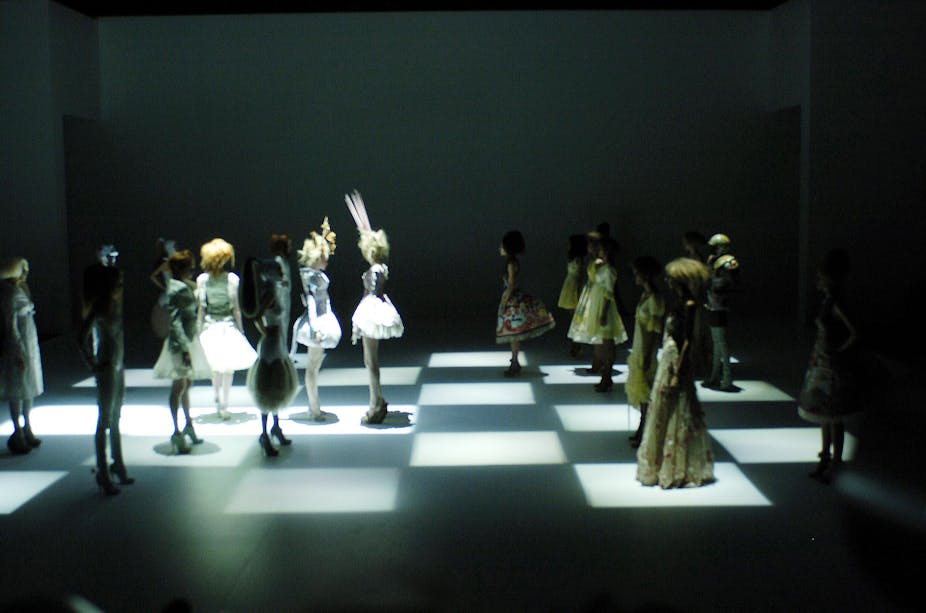London is about to experience an Alexander McQueen extravaganza. A show at the Tate Britain has just opened featuring Nick Waplington’s photographs of McQueen’s work in the run-up to his final autumn/winter collection in 2009.
But all the talk is about the long awaited Alexander McQueen: Savage Beauty, which opens at the Victoria and Albert Museum on March 14. This is an expanded and re-curated version of the exhibition first shown at New York’s Metropolitan Museum of Art, where it attracted more than 660,000 visitors in three months and devotees reportedly queued for up to five hours to get in. Its runaway success looks to be repeated in London, where the exhibition has already been extended until August to cope with demand.
So what is the reason for McQueen’s phenomenal popularity? Commentators regularly cite the tragic lure of his early death, his role as agent provocateur of the fashion world, and of course the beauty, originality and technical skill of his creations. But one element of his allure is mentioned much less frequently: the overtly gothic quality of much of his work.

Gothic, not goth
The term “gothic” is an ambivalent one in the fashion press. Although regularly invoked by fashion editors, its association with “goth”, a youth subculture that emerged in early 1980s Britain and is often derided as hackneyed and gauche by outsiders, makes it déclassé for many designers. But this is a misrepresentation of both goth itself, a complex and evolving subculture, and the broader term gothic that informs it. Gothic refers to a rich and multivalent cultural tradition that is both distinctively British and distinctively of the moment.
The gothic has been one of the UK’s greatest cultural exports, from the novels of the 18th and 19th centuries that defined the genre to the subcultural music and style that continues to throw a long shadow over global youth culture. But after a long period in which the cultural establishment seemed slightly embarrassed about the nation’s gothic leanings, it appears it is finally ready to embrace them.
That such a change in sensibility has occurred can be seen from a series of major events at big public institutions. The British Film Institute’s Gothic: The Dark Heart of Film, a six-month season of events and screenings held in 2013-14, was their most ambitious season to date. The British Library’s Terror and Wonder: the Gothic Imagination followed shortly afterwards in October 2014, and was likewise the biggest event of its kind.

From vampires to sportswear
And it’s not just the museums. The gothic is everywhere in popular media too. From Twilight to American Horror Story, Hannibal to Lady Gaga (who wears ensembles from McQueen’s Plato’s Atlantis in the video for Bad Romance), gothic is becoming one of the dominant modes of our time. Since the later 1990s, it has been an almost permanent fixture on the catwalk. It is reinvented for each new season, its latest iteration “health goth”: a trend for darkly inclined sportswear that inspired Alexander Wang’s 2014 collection for H&M, among others.
Health goth is derived directly from street style, the juxtaposition of two styles that seem incompatible, fused into something new. McQueen’s use of gothic is more multifaceted – it draws on a broad vocabulary from literary, cinematic, art and fashion history to pose important questions about our relationships with our bodies, about desire, about mortality.
McQueen’s work speaks to our current love of the gothic like that of no other designer. Virtually all his work, from his MA graduation show, Jack the Ripper Stalks His Victims (1992), to his final unfinished collection (autumn/winter 2010), inspired by medieval ecclesiastical painting, engages with the gothic on one level or another.
Obsessed with the past
And the most overtly gothic is very gothic indeed. The Hunger (spring/summer 1996) was named after the cult vampire film starring Catherine Deneuve and David Bowie and featured a transparent, moulded plastic corset encasing a layer of worms. And then Eclect Dissect, his autumn/winter 1997 show for Givenchy, was themed around a fictitious Victorian surgeon who collected women, animals and clothes from around the world and cut up and reassembled them. Supercalifragilistic (autumn/winter 2002), his tribute to Tim Burton, mixed up Batman with Grimm’s fairy tales and Marie Antoinette, and was staged in the prison where the French queen awaited the guillotine.

But perhaps the most quintessentially gothic quality of McQueen’s work is his fascination with history. Hauntings, revenants, ancestral curses and uncanny returns are the most definitive property of the kind of gothic found in films and books. The past also weighs heavy on the present for McQueen, whether the oppression of Scotland by England in Highland Rape (autumn/winter 1995) and Widows of Culloden (autumn/winter 2006), or the execution of an ancestor as a witch in In Memory of Elizabeth Howe, Salem, 1692 (autumn/winter 2007). This sense of troubling histories working their way to the surface is expressed in the clothes themselves: in distressed fabric; screen-printed photographs; fragments of historical dress disassembled and reordered.
It is poignant, then, that McQueen’s work is increasingly read in the context of his own troubled past. His legacy is far more important than this. In his vividly original use of a gothic vocabulary to explore his own preoccupations, he offers a distilled expression of the preoccupations of our time.
Alexander McQueen: Savage Beauty runs from March 14 – August 2 2015 at The V&A.

